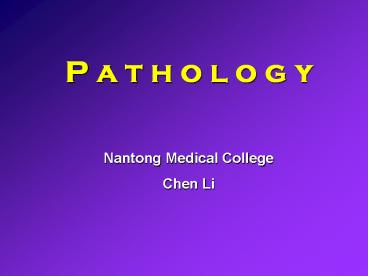P a t h o l o g y PowerPoint PPT Presentation
1 / 26
Title: P a t h o l o g y
1
P a t h o l o g y
Nantong Medical College Chen Li
2
Introduction to pathology
3
The role of pathology in medicine
- Pathology is the study of disease by scientific
methods. - Pathology is a discipline bridging clinical
practice and basic science - pathologists are doctors who are concerned
primarily with the study of disease in all it
aspects, that is, causation diagnosis,
pathogenesis, mechanisms, natural history,
anatomic and biochemical features, progression,
and prognosis.
4
The content and task of pathology
- The object of pathological study aim at diseases.
- What is disease?
- Disease may be identified as an abnormal
variation in the morphological, structure and
function of any part of body. In other words, a
disease is a normal condition of body caused a
loss of normal health (dis-ease)
5
- Old adage that pathologist are doctors doctors
and consultants with specialized knowledge that
can be helpful to the clinician who is caring
directly for the patients. - Pathology is the foundation of medical science
and practice. Without pathology ,the practice of
medicine would be reduced to myths and folk.
6
- Each separated name disease is characterized by a
distant set of features. including - Etiology The cause of a disease
- Pathologenesis The mechanism causing the disease
- Pathological and clinical manifestations The
structure and functional features of the disease - Complication and sequelae The second, systematic
or remote consequence of a disease - Prognosis The anticipated course of the disease
in terms of cure, remission, or fate of the
patient - Epidemiology The incidence and population
distribution of a disease
7
- Pathology focuses on four aspects of disease
- (1) Its cause (etiology)
- (2) The mechanism of its development
(pathogenesis) - (3) The structural alterations induced in
cells and tissues (morphology) - (4) The functional consequences of the
morphologic changes, as observed clinically.
8
- Modern pathology has some major subdivisions
- (1) Histopathology. The investigation and
diagnosis of disease from the - examination
of tissues - (2) Cytopathology. The investigation and
diagnosis of disease from the - examination of
isolated cells. - (3) Haematopathology. The study of disorders of
the cellular and -
coagulable components of blood. - (4) Microbiopathology. The study of infectious
diseases and the -
organisms responsible for them. - (5) Immunopathology. The study of the
specific defence mechanisms of - the
body. - (6) Chemical pathology. The study and
diagnosis of disease from the -
chemical changes in tissues and fluids - (7) Genetics pathology. The study of abnormal
chromosomes and genes, -
those influence on the disease. - (8) Toxicology pathology. The study of the
effects of known or suspected -
poisons. - (9) Forensic pathology the application of
pathology to legal purposes (e.g. -
investigation of death in suspicious
circumstances).
9
Pathology includes two major parts General
Pathology is the study of the basic principles of
pathological processes involved in disease (e.g.
congenital versus acquired diseases,
inflammation, tumor, and degeneration)
Systematic pathology in the study of structure
and functional abnormalities of a specific
disease of body organs or system, such as
respiratory system (lung cancer), digestive
system (appendities) and so forth.
10
The methods of pathological research
Clinical Pathology experimental
Pathology autopsy (A)
animal experiment biopsy (B)
cell culture . cytology
(C)
11
Clinical pathology
Clinical pathology is studying a patient's
illness which is based on the patient's history,
morphological manifestation and make a diagnosis,
and the treatment in clinical.
12
1. Autopsy
Autopsy (necropsy and postmortem examination
are synonymous) means to see for oneself.
The autopsy continues to have an important
role. Determine the cause of death Make the
accuracy of clinical diagnosis Education of
medical students and clinicians Research into the
causes and mechanisms of disease Gathering
accurate statistics about disease incidence
The autopsy rate has declined precipitously
throughout the United States.
13
(No Transcript)
14
2.Biopsy
Biopsy is often favored because it provides
generous amounts of tissue for diagnosis and may
itself afford sufficient surgical therapy for
some tumors. frozen sections permanent sections
15
3.Cytology
Cytology is used for both screening and
diagnosing of lesions. This study of disease
processes involves cell smears from various
orifices (e.g., vagina, mouth, bronchus) of the
fine needle aspiration (FNA) of any mass of lymph
node.
All future clinicians should recognize that
modern pathologists cannot operate in a vacuum,
but must coordinate their impressions with the
clinical situation.
16
(No Transcript)
17
(No Transcript)
18
Experimental pathology 1.Animal experiment
The animal experimental methods are applied
to replicate some models of human disease in
order to investigate the etiology, pathogenesis,
pathological change and the results of the
disease. It is an important reference to
human disease
19
(No Transcript)
20
2. Cell culture
Cell cultures are widely used in research
and diagnosis. They are an attractive medium for
research because of the ease with which the
cellular environment can be modified and the
responses to it monitored.
Diagnostically, cell cultures are used to prepare
chromosome spreads for cytogenetic analysis.
21
The method of pathological observations
Gross pathology Light microscopy Histochemistry I
mmunohistochemistry Electron microscopy
22
(No Transcript)
23
History of pathology
Humoral pathology Ancient Greek Organic
pathology Antonio Benivieni (1440-1502)
Giovanni Battista Morgagni (1682-1771) Cellular
pathology Application of microscopy
Rudolf Virchow (1821 -1905) Molecular pathology
Polymerase chain reaction (PCR)
Flow
cytometry
24
- We are now entering an era in which it will be
more important to identify markers that help to
predict the response to new and different
therapeutic modalities. - It has not yet reached standard practice but
promises a golden age for pathology in the next
decade.
25
??,??,?????,???????,????????????????,???????
??????????????????????????????????????????8?,????
??EBV??????????????????????????00??02??????????
??????02???????????????????03???????????? ??????
1 ????????????????? 2 ?????????? 3
?????????????????????? 4 ??????????????????
5 ????????????????????? 6 ??????????????????????
? 7 ??????????????????? 8 ???????????????????
9 ???????? 10 ??????????
26
see you next time!

